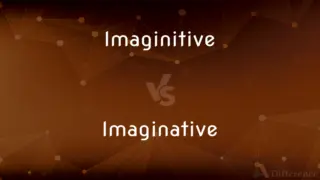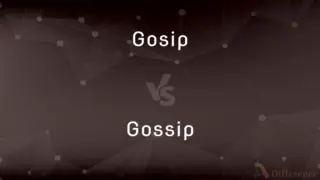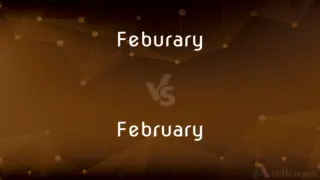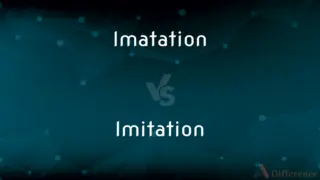Aperturate vs. Aperture — Which is Correct Spelling?
Edited by Tayyaba Rehman — By Maham Liaqat — Updated on April 16, 2024
Aperturate is the incorrect spelling of aperture, which refers to an opening, hole, or gap, especially one that allows light to pass through.

Table of Contents
Which is correct: Aperturate or Aperture
How to spell Aperture?

Aperturate
Incorrect Spelling

Aperture
Correct Spelling
ADVERTISEMENT
Key Differences
Practice spelling by focusing on the ending "-ture", which is typical for nouns, distinguishing it from the verb-forming "-ate".
Remember the relation of aperture to "apex" emphasizing an opening or peak, not a verb action like "-ate" might imply.
The correct term aperture ends with "-ture", a common ending for nouns describing a state or quality, like "fixture" or "nature".
Recall that aperture relates to "open" and avoids the unnecessary suffix "-ate".
How Do You Spell Aperture Correctly?
Incorrect: The size of the aperturate affects the brightness of the photograph.
Correct: The size of the aperture affects the brightness of the photograph.
ADVERTISEMENT
Incorrect: Adjusting the aperturate can dramatically change the image's focus.
Correct: Adjusting the aperture can dramatically change the image's focus.
Incorrect: He examined the aperturate to see how much light was entering.
Correct: He examined the aperture to see how much light was entering.
Incorrect: The microscope's aperturate needed to be adjusted to get a clearer image.
Correct: The microscope's aperture needed to be adjusted to get a clearer image.
Incorrect: The camera's aperturate setting was adjusted for the bright conditions.
Correct: The camera's aperture setting was adjusted for the bright conditions.
Aperture Definitions
In biology, an opening or orifice on an organism.
The aperture of a mollusk's shell helps it to manage water flow.
An opening or hole through which light travels in an optical system.
The aperture of the camera controls how much light hits the film.
A gap or space that permits the passage of light or other elements.
The aperture in the wall was used to observe the stars.
A variable opening in an optical instrument that limits the amount of light.
Telescopes use a large aperture to gather more light from distant objects.
The diameter of the lens opening in a camera, often adjustable.
By changing the aperture, the photographer could control the depth of field.
In optics, an aperture is a hole or an opening through which light travels. More specifically, the aperture and focal length of an optical system determine the cone angle of a bundle of rays that come to a focus in the image plane.
An opening, such as a hole, gap, or slit.
A usually adjustable opening in an optical instrument, such as a camera or telescope, that limits the amount of light passing through a lens or onto a mirror.
The diameter of such an opening, often expressed as an f-number.
The diameter of the objective of a telescope.
A small or narrow opening, gap, slit, or hole.
An aperture in a wall
Piriform aperture
(optics) A hole which restricts the diameter of the lightpath through one plane in an optical system.
The diameter of such a hole which restricts the width of the lightpath through the whole system. For a telescope, this is the diameter of the objective lens.
Angular aperture
This telescope has a 100 cm aperture.
The (typically) large-diameter antenna used for receiving and transmitting radio frequency energy containing the data used in communication satellites, especially in the geostationary belt. For a comsat, this is typically a large reflective dish antenna; sometimes called an array.
The maximum angle between the two generatrices.
If the generatrix makes an angle θ to the axis, then the aperture is 2θ.
The act of opening.
An opening; an open space; a gap, cleft, or chasm; a passage perforated; a hole; as, an aperture in a wall.
An aperture between the mountains.
The back aperture of the nostrils.
The diameter of the exposed part of the object glass of a telescope or other optical instrument; as, a telescope of four-inch aperture.
A device that controls amount of light admitted
A natural opening in something
An man-made opening; usually small
Aperture Meaning in a Sentence
Scientists measure the aperture of pollen grains under a microscope.
By adjusting the aperture, the photographer was able to blur the background.
The telescope's large aperture allows it to collect more light from distant galaxies.
A smaller aperture increases the depth of field in a photograph.
Cameras with a fixed aperture are less versatile than those with an adjustable one.
The aperture of the cave was small, making it difficult to enter.
Aperture priority is a common setting on cameras that lets the photographer choose the aperture while the camera selects the shutter speed.
Adjusting the aperture on the microscope allows you to see finer details.
The iris of your eye changes aperture to control how much light enters.
He adjusted the aperture to reduce the glare in his photograph.
The aperture controls how sharp or blurry the background appears in a photo.
Adjust the aperture to capture either detailed landscapes or focused portraits.
Aperture adjustments are a vital part of photographic composition.
The architect designed the windows with a specific aperture to maximize sunlight.
When the aperture is wide, more light enters the camera, resulting in a brighter image.
Understanding aperture is essential for photographers who want to control light and focus.
The aperture was set too small, causing the photo to be underexposed.
The aperture of the microscope was carefully calibrated for the experiment.
The aperture setting is crucial for achieving the desired exposure in photography.
In cardiology, the aperture of a heart valve is critical for blood flow.
Botanists study the aperture of seeds to understand their dispersal mechanisms.
The cave's aperture was just large enough for the explorers to squeeze through.
A larger aperture is preferred for portrait photography to blur the background.
She experimented with different aperture settings to see their effects on her photos.
His new camera has a range of aperture settings, giving him creative control over his images.
Aperture Idioms & Phrases
Adjust the aperture
To change the size of the opening in the lens to control light and depth of field.
Adjust the aperture to brighten or darken your photo.
Narrow aperture
A smaller opening in the lens, allowing less light and increasing depth of field.
A narrow aperture is ideal for landscape photography to keep everything in focus.
Aperture priority
A camera mode where the user sets the aperture and the camera adjusts the shutter speed.
She often shoots in aperture priority mode to control the depth of field.
Maximum aperture
The largest opening possible with a particular lens, important in low light conditions.
Lenses with a large maximum aperture are preferred for indoor photography.
Minimum aperture
The smallest opening a lens can achieve, used for maximizing the area in focus.
For sharp group photos, set your lens to its minimum aperture.
Aperture scale
A series of numbers on a lens that indicates the size of the aperture.
He learned to read the aperture scale to better understand his lens capabilities.
Wide aperture
A setting that allows a lot of light to pass through, often creating a shallow depth of field.
He used a wide aperture to create a blurred background effect.
Aperture effect
The impact of aperture settings on the appearance of a photograph.
The aperture effect on depth of field is a key creative tool in photography.
Aperture setting
Refers to the configuration of the camera's aperture for taking photos.
Check the aperture setting before you begin shooting to ensure it suits your needs.
Aperture adjustment
The process of changing the aperture setting on a camera or lens.
Aperture adjustment is a crucial skill for professional photographers.
Aperture manipulation
Intentionally altering the aperture to achieve a specific photographic effect.
Aperture manipulation requires understanding how light interacts with the camera sensor.
Aperture control
The function on a camera that allows the aperture to be adjusted.
Aperture control is essential for managing light in your photographs.
Close aperture
Setting the aperture to a very small size to restrict light entry.
Close aperture is useful for capturing details in bright conditions.
Aperture range
The range between the maximum and minimum aperture a lens can achieve.
This lens has an aperture range suitable for various photography styles.
Variable aperture
A lens feature where the aperture size changes depending on the zoom level.
Variable aperture lenses are more complex and can affect exposure during zooming.
Open aperture
Refers to a setting where the aperture is set to allow the maximum amount of light.
Open aperture is used in dim lighting to capture clearer images.
Fixed aperture
A lens characteristic where the aperture size does not change regardless of the zoom level.
Fixed aperture lenses maintain consistent exposure settings throughout the zoom range.
Optimal aperture
The aperture setting that provides the best balance of sharpness and depth of field for a particular situation.
Finding the optimal aperture can significantly enhance photo quality.
Manual aperture control
The ability to set the aperture manually, as opposed to automatic or preset adjustments.
Manual aperture control gives photographers more creative freedom.
Aperture optimization
The process of selecting the best aperture setting for a given photographic condition.
Aperture optimization is key in achieving professional-level results.
Common Curiosities
How many syllables are in aperture?
There are three syllables in aperture.
Why is it called aperture?
Aperture comes from the Latin word "apertura," which means opening, reflecting its function as an opening in lenses or other devices.
How is aperture used in a sentence?
Aperture is commonly used to refer to the adjustable opening in cameras that controls the amount of light entering.
What is the pronunciation of aperture?
Aperture is pronounced as /ˈæp.ə.tʃər/.
What is the root word of aperture?
The root word of aperture is the Latin "apertus," meaning open.
What is a stressed syllable in aperture?
The stressed syllable in aperture is the first syllable: "a."
What part of speech is aperture?
Aperture is a noun.
How do we divide aperture into syllables?
Aperture is divided into syllables as follows: a-per-ture.
What is the verb form of aperture?
Aperture is a noun; it does not have a verb form.
What is another term for aperture?
Another term for aperture is opening.
Is aperture a noun or adjective?
Aperture is a noun.
Is aperture an abstract noun?
No, aperture is a concrete noun, as it refers to a physical opening.
Is the aperture term a metaphor?
The term aperture can be used metaphorically to describe an opportunity or means of access.
Is the word aperture imperative?
No, aperture is a noun and cannot be imperative.
Is the word aperture Gerund?
No, aperture is not a gerund; it is a noun.
What is the opposite of aperture?
The opposite of aperture could be closure or seal.
Is aperture an adverb?
No, aperture is not an adverb.
Is aperture a negative or positive word?
Aperture is a neutral word; it is neither inherently negative nor positive.
Is aperture a vowel or consonant?
Aperture starts with a vowel sound.
Is aperture a collective noun?
No, aperture is not a collective noun.
Which determiner is used with aperture?
Determiners such as "an," "the," or "this" can be used with aperture.
Which vowel is used before aperture?
"An" is used before aperture because it starts with a vowel sound.
Which preposition is used with aperture?
Common prepositions used with aperture include "of" and "at."
Which article is used with aperture?
The article "the" is often used with aperture.
What is the singular form of aperture?
The singular form is aperture.
What is the plural form of aperture?
The plural form is apertures.
Is the word “aperture” a Direct object or an Indirect object?
Aperture can be used as a direct object in a sentence.
Is aperture a countable noun?
Yes, aperture is a countable noun.
Which conjunction is used with aperture?
Conjunctions like "and" or "but" are commonly used with aperture.
Share Your Discovery

Previous Comparison
Brittan vs. Britain
Next Comparison
Accoustic vs. AcousticAuthor Spotlight
Written by
Maham LiaqatEdited by
Tayyaba RehmanTayyaba Rehman is a distinguished writer, currently serving as a primary contributor to askdifference.com. As a researcher in semantics and etymology, Tayyaba's passion for the complexity of languages and their distinctions has found a perfect home on the platform. Tayyaba delves into the intricacies of language, distinguishing between commonly confused words and phrases, thereby providing clarity for readers worldwide.


































